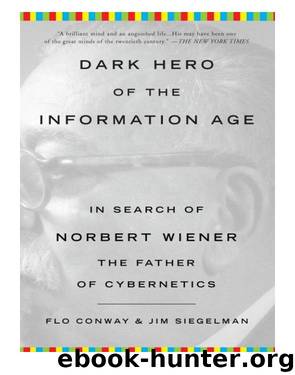Dark Hero of the Information Age by Conway Flo; Siegelman Jim;

Author:Conway, Flo; Siegelman, Jim;
Language: eng
Format: epub
Publisher: Basic Books
Published: 2012-01-31T16:00:00+00:00
“I didn’t know what happened until Arturo told me ten years later,” said Lettvin. Early in the 1960s, Lettvin and his wife Maggie paid a visit to Rosenblueth and his wife Virginia in Mexico. At dinner in a posh Mexico City restaurant, Lettvin asked Rosenblueth if he had any insight into Wiener’s actions so many years ago and his continuing silence with the entire McCulloch group.
“Don’t you know?” asked Rosenblueth, incredulous, then he proceeded to replay the events of that fateful night in December 1951. He recounted Wiener’s torment over the writing of his autobiography and his progressive despair at the flood of rejection letters. He confirmed the bad timing of Pitts and Lettvin’s jocular letter and the last, crushing rejection Wiener received from the director of Technology Press on the first Saturday in December 1951. It was at that low point, at a glum dinner the Wieners and Rosenblueths were sharing just hours after Wiener had received the rejection, that Margaret told Wiener something appalling and far more disturbing. She said that the boys in McCulloch’s group—Wiener’s boys—had seduced his elder daughter during her stay at the McCulloch home in Chicago four years earlier. In her damning indictment, as Lettvin recalled Rosenblueth’s words, Margaret alleged that not one but “more than one” of the boys had seduced the chaste nineteen-year-old during her first foray away from home and the protected environment of her boarding school.
Wiener paled. His mind staggered at the thought of the boys defiling his “pure universal” in McCulloch’s lair of iniquity. The next morning, he sent his angry telegram to Jerome Wiesner and wrote his long letter to President Killian formally severing all relations with McCulloch and his team at the RLE.
It was a gangbuster revelation, except for one important detail: The whole story was a fabrication. “She made it all up!” said Lettvin. “There was nothing to it.” At a moment when she felt herself to be in danger of losing control over Wiener’s territory and affairs, consciously or not, she took a page from her favorite book and chose to propagate a big lie where no little lie, or the truth by any stretch, would suffice. After two decades spent discrediting her elder daughter and falsely blaming her for “spreading lies that ruined men’s reputations,” Margaret Wiener did just that—and used her daughter, yet again, as her scapegoat.
A less vulnerable and more even-tempered man might have sought to validate those serious accusations before he acted on them, but Wiener did not question Margaret’s version of the events. He did not discuss her allegations with Barbara, who had never made any such claims to her mother. Nor did he give his accused colleagues a chance to respond to Margaret’s charges, or even to know they had been charged.
Margaret’s plan worked perfectly. By charging McCulloch and his team in toto with a grave and intimately personal offense, she insured the secrecy of her scheme. Wiener would not divulge his daughter’s supposed shame to anyone in those discreet days of the 1950s.
Download
This site does not store any files on its server. We only index and link to content provided by other sites. Please contact the content providers to delete copyright contents if any and email us, we'll remove relevant links or contents immediately.
Hit Refresh by Satya Nadella(8367)
When Breath Becomes Air by Paul Kalanithi(7302)
The Girl Without a Voice by Casey Watson(7291)
Do No Harm Stories of Life, Death and Brain Surgery by Henry Marsh(6357)
A Court of Wings and Ruin by Sarah J. Maas(6161)
Hunger by Roxane Gay(4254)
Shoe Dog by Phil Knight(4210)
Everything Happens for a Reason by Kate Bowler(4086)
A Higher Loyalty: Truth, Lies, and Leadership by James Comey(4066)
The Rules Do Not Apply by Ariel Levy(3944)
Tuesdays with Morrie by Mitch Albom(3866)
The Immortal Life of Henrietta Lacks by Rebecca Skloot(3850)
How to Change Your Mind by Michael Pollan(3704)
Millionaire: The Philanderer, Gambler, and Duelist Who Invented Modern Finance by Janet Gleeson(3604)
All Creatures Great and Small by James Herriot(3549)
Elon Musk by Ashlee Vance(3476)
Tokyo Vice: An American Reporter on the Police Beat in Japan by Jake Adelstein(3464)
Man and His Symbols by Carl Gustav Jung(3351)
The Money Culture by Michael Lewis(3317)
